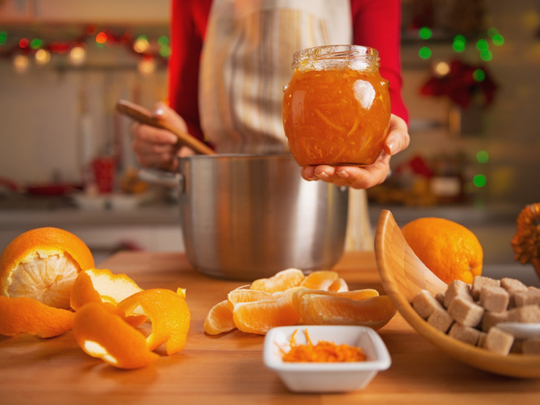
Mrs Whitaker’s table is a riot of colour. Yet, the colour comes not from a tablecloth. The table is covered with fruit, corner to corner. The same fruit, but what a variance of shades! I lose count of how many different hues I can detect. If there are 50 shades of orange, then they are all represented here I am sure — from the pale tone known as ‘papaya whip’ all the way through to tangerine and even further on, to butterscotch.
As vast as it may be, the English language has no rhyming word for ‘orange’, but what it lacks in rhyme it more than makes up for in assorted shades. The sight is quite staggering and soothing at the same time. Plus, the air in the Whitaker dining room is so fruity fresh. All of which may lead the reader to conclude that the Whitakers are orcharders. But no. They grow no more than a few flowering plants. The oranges are from a friend of theirs and it is he who owns an orchard. Pictures show the endless stretch of orange trees, all of them pregnant and pendulant with fruit, their branches bowing earthward under the weight.
As a seasonal gift, even a table load of oranges can be one table-load too many for a small family to consume, so the Whitakers, in turn, gift these away to friends of theirs. It’s a bit like largesse spread around. One friend of theirs, Sam, takes the ‘gift giving’ a step further. When he gets home with his bagful of oranges, he selects eight of the very best.
I stand and watch as he washes them thoroughly under running water before patting them dry. Next, he fetches a zester from out of a kitchen drawer and proceeds in roughly five minutes to zest all eight of them. Then with a sharp knife he chops up the zested peel and puts it aside. After this he cuts each orange in half and juices the lot which he then strains, to remove any pulp and seeds. He collects the juice in a measuring mug.
Once this is done, he throws the zested peel into the strained juice and takes note of what quantity he has. It shows just over two cups. To this he adds a quantity of water until it gives him four cups worth of liquid. This he transfers to the stove top and proceeds to bring to the boil and as soon as that is done, he lowers the flame and allows the juice to simmer for ten minutes. Next, he adds two packets of gel-it-in, “Or any pectin of your choice” he tells me, as he stirs the lot thoroughly, brings it back to the boil and then adds six cups of sugar. “Use organic if you can,” he advises. It looks like a lot — a quantity to send anyone who is diabetes afflicted scooting away, but it’s the amount he says that’s needed. It also, like sugar often does, melts very quickly under heat.
Meanwhile, he’s turned on his oven and placed six jam bottles inside on a low temperature of 100 degrees Celsius. As soon as the sugar reaches boiling point, he turns off the stove and says, “That’s that!” And that, apparently, is all it takes to make six bottles of marmalade! I watch in amazement because I always thought jam-making was an involved process. But Sam’s done it all within an hour! The six bottles of jam will sit and cool and the next day he’ll hand these, in turn, as gifts to his friends. In this way, the circle of gift-giving spreads, outward and onward.
The original gift giver, the Whitakers’ friend with the orange orchard, has no idea how many people his oranges have touched. And I, who brought home a bagful of oranges too, thought the best way I could spread the gift was by telling my readers how to make marmalade when life gives you oranges.
Kevin Martin is a journalist based in Sydney, Australia.










